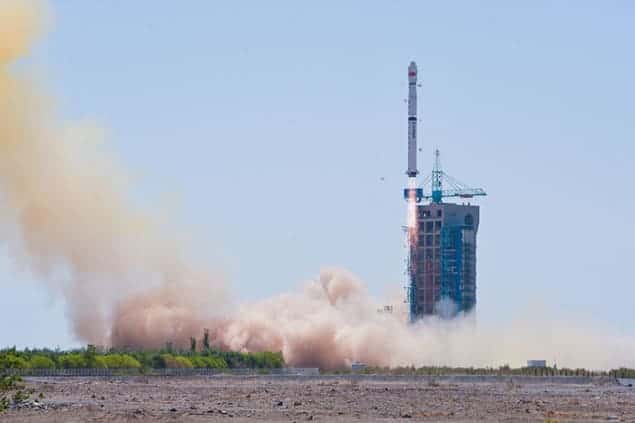
China has launched the country’s first dedicated X-ray telescope to study the radiation produced by black holes and neutron stars as well as detect gamma-ray bursts. The 1bn RMB Hard X-ray Modulation Telescope (HXMT) was launched today at 11:00 local time from the Jiuquan Satellite Launch Center in north-western China’s Gobi Desert. It will now be put into low-Earth orbit with an altitude of around 550 km.
First proposed in 1994 and approved in March 2011, HXMT has been developed jointly by the China Academy of Space Technology, Tsinghua University and the Institute of High Energy Physics (IHEP) of the Chinese Academy of Sciences. The 2700 kg probe carries three instruments that will detect X-rays between 1–250 keV. The high-energy X-ray instrument has a total collecting area of 5000 cm2 and will work between 20–250 keV. The instrument will also be able to detect gamma-ray bursts at energies 3 MeV. “We expect to monitor about 200 gamma-ray bursts every year,” says IHEP physicist Shuangnan Zhang, who is the principal investigator of the satellite. The medium-energy X-ray instrument will operate between 5–30 keV while the low-energy X-ray instrument will work from 1–15 keV.
Due to atmospheric absorption, cosmic X-rays can only be seen from space with black holes and neutron stars being the two main sources in the universe. By combining sky-survey data with single-point observations, HXMT will develop a high-precision, hard X-ray sky map, looking for new sources and studying in greater detail the temporal properties of known sources to significantly improve our knowledge of the X-ray sky.
Modulation detection
Dedicated X-ray astronomy began in 1970 with the launch of NASA’s Uhuru and since then there have been more than 50 missions, including NASA’s Chandra and the European Space Agency’s XMM-Newton. But instead of using focusing optics to identify X-ray sources, HXMT adopts a unique “modulation” technique to detect X-rays. “We use collimators to filter the incoming light so that only radiation travelling in a specific direction is allowed through,” says Zhang. By swinging the detector in various directions, astronomers can then reconstruct a specific source and eventually render a map of the entire X-ray sky.
Paolo Giommi, an astronomer at the Italian Space Agency, says that the modulation technique is “clever” because it does not require “complex and costly X-ray mirrors”. That view is backed by astronomer Jonathan Grindlay from Harvard University, who says that the strength of the modulation technique is its simplicity. “With HXMT’s broad energy band coverage for wide-field imaging, it should obtain better spectral energy distribution than what is now being done with [NASA’s Monitor of All-sky X-ray Image],” he adds.
Joint observations
However, HXMT’s sensitivity will be limited by using this approach, so Zhang’s team is planning to carry out joint observations with other missions such as NASA’s NuSTAR, which was launched in 2012.
Data from the HXMT will also be shared with international collaborators including those at the University of Tübingen’s Institute of Astronomy and Astrophysics. Zhang and colleagues from Tübingen are also working on the proposal for a successor to HXMT – the enhanced X-ray Timing and Polarimetry mission. If approved, it will be an international project involving more than 20 nations and led by China with a launch date as early as 2024/2025.



